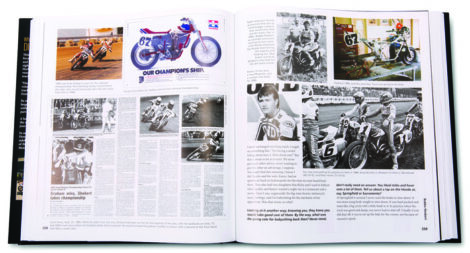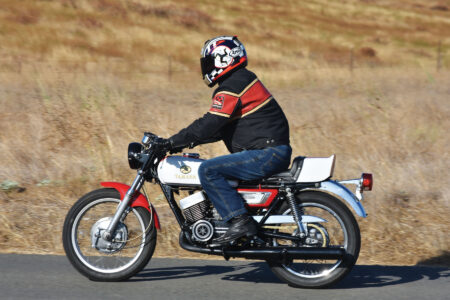Before we discuss Gerald Foster’s (with Chris Carter) book When Honda Went Dirt Track Racing — truly a titanic tome packing 544 pages within hardbound covers measuring 12-3/8-inches by 11-1/4-inches and weighing a hefty 7.25 pounds — we should talk about the real elephant in the room. That, of course, is that flat track racing is an American sport dating back to (seemingly) the early days of dirt itself.
Honda? Well, it’s a motorcycle (and automotive) company that originated in Japan back in 1948, not doing business on these shores until mid-1959. And during that span of 11 years every racer to win the AMA Grand National Championship did so riding a Harley-Davidson.
Not even Honda’s celebrated 1970 Daytona 200 win (Dick Mann on a CB750) could elevate the company’s Grand National Championship status among AMA hierarchy because that single race was on pavement, not good ol’ ‘Merican dirt. It wasn’t until 1979 when Mickey Faye, riding a modified Honda XR500, won the TT National at the Houston Astrodome that the Japanese company finally made inroads into dirt track racing. And, almost on cue, Honda answered the siren song with a rather peculiar and unorthodox V-twin racer based on its CX500 street model.
Honda’s flat track addiction
That concoction led to Honda’s flat track addiction. As Dave Despain relates in the book’s Introduction, Honda’s CX500 flat track racer was spotted at the 1979 San Jose Mile “by Honda’s Shoichiro Irimajiri, a race-savvy heavy hitter who would eventually run Honda’s entire American operation,” wrote Despain, “and who also designed the CX500! (Coincidence and good luck indeed.)” Despain continued, “Irimajiiri was hooked.”
And so American Honda committed to a dirt track racing program in 1979. That effort was essentially spearheaded by Jerry Griffith’s personal pursuit of converting a Honda CX500 for flat track racing, and by chance, another CX500 program popped up in the cornfields of Iowa when a resourceful engineer named John Kite began experimenting with his own Honda CX500-based flat track racer (see Motorcycle Classics, July/August, 2018). The race was on, so to speak, even though neither builder was aware of the other’s project at that time.
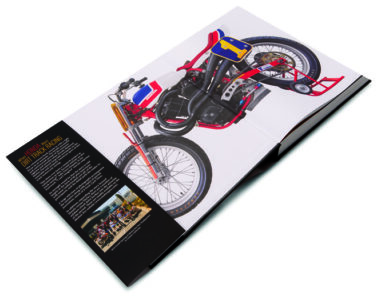
Finally, on June 5, 1982, Scott Pearson won the Louisville Half-Mile on a bored and stroked CX500 re-named NS750. But it wasn’t until Ricky Graham won the coveted Number One Plate in 1984, riding an RS750, that the AMA racing establishment fully acknowledged Honda as a player. And that’s the premise of this book: Honda winning one of the oldest and most sought-after motorcycle championships in America.
Interestingly, Foster’s book was, in a manner of speaking, conceived in America’s heartland when, in 2012, he attended a bike show at John and Jill Parham’s National Motorcycle Museum in Anamosa, Iowa. There Foster met with Motion Pro’s Chris Carter (himself a former racer and current classic bike collector) and seasoned book publisher Tim Parker. By chance Carter had one of his early Honda flat trackers on loan to the museum, and, well, one thing led to another until Foster (an expatriated Englishman and retired American Honda employee) was convinced by Carter and Parker that writing a book about Honda’s flat track racing endeavors was a good idea; after you read this book, you, too, will agree that it was, indeed, a good idea. It’s not a stretch to say that When Honda Went Flat Track Racing is the most comprehensive work on the topic.
Foster’s narrative is truly complete, treating readers to plenty of big and insightful photos (color and black & white, many at the hands of expert lensman Bert Shepard). Photos reveal race action and technical detail of race bikes and riders, accompanied by clippings from period magazines, plus full race reports from Cycle News describing the action as it unfolded on the racetrack.
Read over 60 interviews
Perhaps the real jewels to be found in the book are the 60-plus interviews of American Honda team members and other people associated with the racing, and of people involved in subsequent years. These voices give a true sense of what happened during that unforgettable time.
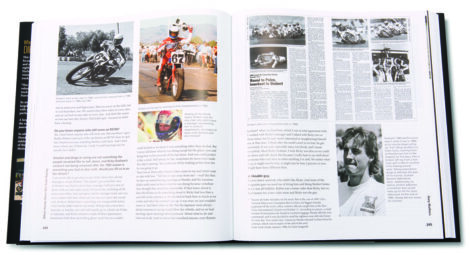
Moreover, Foster took care to thoroughly edit each interview before returning a working manuscript to the interviewees for proofreading and confirmation before publication. Doing so assures readers that there’s no confusion (other than the occasional time-lapse memory fog that, in itself, is a part of life’s experiences) about what took place and when during Honda’s flat track success that culminated with four straight AMA Grand National Championships (Ricky Graham, 1984, and Bubba Shobert 1985-’87) plus Graham’s seemingly magical title in 1993 when, as a privateer for John and Sarah Goad, he posted a remarkable 12 National wins.
Foster’s interviews start with the beginning days when Dennis McKay served as American Honda’s director of racing. It was under his management that American Honda began its flat track program (with a modified XR500 single on which Jeff Haney consistently beat Harley XR750s at weekly Ascot meets) that eventually led to Graham earning Number One. Foster follows that with the nearly insurmountable number of interviews, ranging from Griffith and Kite’s early CX500 ventures to the riders and insiders such as Graham’s parents and girlfriend Regina Smith (who, ironically, was the first Miss Harley-Davidson, 1983 and ’84). Teammate Shobert tells his story, plus various sponsors, vendors and privateers, and other players who helped support Honda RS750 racing efforts recall their involvement.
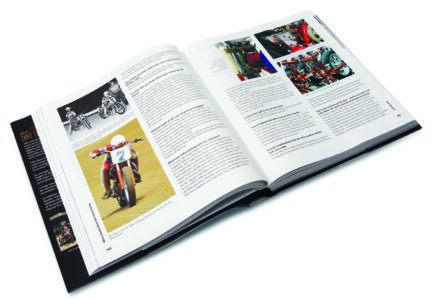
It’s easy reading, too. The interviews are listed in page order at the front of the book, making it easy to chase down some of your favorite people from that era to read about their experiences with Honda’s racing program. Sadly, some players, although they were interviewed for the book, are gone and missed today. Gene Romero, Graham and his bike tuner Sparky Edmonston, and Jerry Branch are among those that I knew.
The book could have been even larger than it is, but the printer warned that too many pages might lead to a broken book spine, so Foster and Carter cut the page count at 544. Additional articles and insightful information that missed the cut can be accessed online through a link via Motion Pro, bit.ly/WhenHonda.
No doubt, When Honda Went Flat Track Racing is a big book, and it comes with a rather big price. But if you’re a fan of that great American sport, it’s a wonderful read, accompanied by photos that are in many ways priceless in their own right. The only thing better might be experiencing a full-lock slide at the Springfield Mile — and living to tell about it.
Read About When Honda Went Dirt Track Racing
When Honda Went Dirt Track Racing
By Gerald Foster, with Chris Carter
Hardbound, 544 pages, 12 3/8″ x 11 1/4″
Published by: Chris Carter, Motion Pro, Inc. 2021
$224.99, available through Motion Pro.


